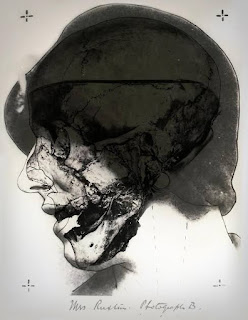The Buck Ruxton "Jigsaw Murders" case Skull no. 2, photograph B, 1935 Investigators photographed the Skull No. 2 in the same orientation as an existing photograph of Mrs. Ruxton. Then they laid a photo-transparency of this skull over the portrait to establish that the skull was Mrs. Ruxton's. On September 14, 1935, Buck Ruxton, an Indian-born physician who lived in Lancashire, near the English-Scottish border, murdered his wife Isabella and her maid Mary Rogerson, and then mutilated their bodies and scattered the parts, in an effort to make them unidentifiable. After a passerby discovered some remains under a bridge in Scotland, a team of forensic experts was assembled. Using an array of scientific methods, the experts identified the victims and unmasked the perpetrator. The painstaking reconstruction of the bodies of Isabella Ruxton and Mary Rogerson by forensic pathologist John Glaister Jr. and anatomist James Couper Brash—and pioneering use of photographic superimpositions—was the key evidence that led to Dr. Ruxton's conviction and execution. The success of the methods used in the Ruxton case, which was widely reported in the press, led to increased public and professional trust in the capabilities of forensic science. Dr. Ruxton's trial, which took place in March 1936, lasted 11 days. He was found guilty and sentenced to be hanged to death. Before his execution, he admitted his guilt.
Dig into history, science, true crime, and beyond with All That's matters — where you'll discover the most interesting things that's matters
Search on Wikipedia
Search results
The first execution by electrocution in history, is carried out against William Kemmler

On August 6, 1890, at Auburn Prison in New York, the first execution by electrocution in history, is carried out against William Kemmler, who had been convicted of murdering his lover, Matilda Ziegler, with a hatchet. William had accused her of stealing from him, and preparing to run away with a friend of his... click image to read story
Search This Blog
holocaust.victims: Grietje van der Kar-Posno was born in Rotterdam on December 9, 1911. She was Jewish, the daughter of Heintje Snoek-Canes ...

-
The 33 Worst Serial Killers Ever To Stalk The Earth From the Giggling Granny to the Candy Man, history's worst serial killers are s...
-
The animal war that you have never heard about, 1974 The Gombe Chimp War was a violent conflict between 2 groups of Chimpanzees in Tanz...
-
The Short, Inspiring Life Of Quentin Roosevelt, Theodore Roosevelt’s Youngest Son Quentin Roosevelt responded to the call of duty and f...
-
In 1996 She Was Rejected Because They Believed , Women Not Physiologically Able To Run A Marathon 11 July 2022 “When she applied to run i...
-
in 1509, King Henry VII of England died of tuberculosis at the age of He drew his final breath in Richmond Palace. He first fell ill...
-
The 1873 Colfax Massacre Was a Racist Attack on Black People’s Democratic Rights Depiction of African Americans gathering the dead and wo...
-
She was 11 when WWI started, 36 when WWII started, 74 when Star Wars was released, and 116 when Covid-19 started. At 119 years, Kane Ta...
-
The Black Death, the man who feared nobody, 1918 Henry Johnson was an African American soldier during World War I. Johnson joined the ...
-
In 1230, Marcher Lord William de Braose was executed by Llywelyn Fawr (the Great) for his affair with the Lady of Wales, Siwan (Joan) Thi...
-
A 2,000-Year-Old Mummy Was Just Found In The Trash In Yemen — And Its Insides Are Missing.... Read story A 2,000-year-old mummy was just f...















